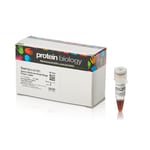Search Thermo Fisher Scientific
Spectra™ Multicolor Broad Range Protein Ladder
| Katalognummer | Menge |
|---|---|
| 26623 | 10 x 250 μl |
| 26634 | 2 x 250 μl |
| 26634X4 | 8 x 250 µl |
Alle anderen Proteinstandards und -leitern anzeigen und vergleichen ›
Anwendungen
• Überwachen der Proteinmigration während der SDS-Polyacrylamid-Gelelektrophorese
• Überwachen der Proteinübertragung auf Membranen nach Western Blotting
• Größenbestimmung von Proteinen in SDS-Polyacrylamid-Gelen und Western Blots
Lagerpuffer: 62,5 mmol Tris-H3PO4 (pH 7,5 bei 25 °C), 1 mmol EDTA, 2 % SDS, 10 mmol DTT, 1 mmol NaN3 und 33 % Glycerin
Lagerung: Nach Erhalt bei –20 °C lagern

Introducing iBlot 3 Western Blot Transfer System
Featuring higher throughput and built-in cooling for consistent protein transfer
Learn more ›
Abbildungen


Kunden, die diesen Artikel ansahen, interessierten sich auch für
Dokumente und Downloads
Zertifikate
Sicherheitsdatenblätter
Product Information
Häufig gestellte Fragen (FAQ)
Coupling of chromophores to proteins affects the apparent molecular weight of proteins in SDS-PAGE relative to unstained standards. The apparent molecular weight of prestained protein standards is calibrated in the classical TRIS glycine-SDS Laemmli system, however prestained proteins may have different mobility in other electrophoresis buffer and gel systems. It should also be noted that the sizing of proteins by gel electrophoresis does not give an exact value and depends on the protein sequence and post-modification.
Find additional tips, troubleshooting help, and resources within our Protein Assays and Analysis Support Center.
The upper bands of the ladder may be degraded by proteases. Ladder, gel, buffer, pipettes, pipette tips, or equipment can be contaminated by proteases during usage. A general recommendation would be to avoid working with proteases in the same room. We would recommend preparing fresh solutions, cleaning the equipment, and using clean pipettes and tips. If the ladder itself is contaminated, please use a new tube of the ladder.
Find additional tips, troubleshooting help, and resources within our Protein Assays and Analysis Support Center.
No, proteins in Thermo Scientific protein ladders are not His tagged. However, non-specific interaction between the ladder proteins and primary or secondary antibodies is possible and some His-Tag detection systems, such as Thermo Scientific 6xHis Protein Tag Stain Reagent Kit, show non-specific interaction. The protein ladder bands are more readily detected when using high antibody concentrations. The non-specific cross-reactivity is difficult to predict, it often has a different pattern dependent on the antibodies used in each individual experiment. The most general way to handle this problem would be to use lower concentrations of antibodies and to use lower amount of protein ladders. It may also be useful to leave one empty well between the ladder and the sample to overcome a possible leakage of the signal to the nearby sample lane.
Find additional tips, troubleshooting help, and resources within our Protein Assays and Analysis Support Center.
PageRuler Unstained protein ladders can be detected directly on Western blots by using Strep-Tactin conjugates or an antibody against the Strep-tag II sequence. All PageRuler and Spectra ladder proteins contain an integral Strep-tag II sequence, however the prestained ladders cannot be detected by Strep-Tactin conjugates.
Find additional tips, troubleshooting help, and resources within our Protein Assays and Analysis Support Center.
All PageRuler and Spectra ladder bands are recombinant prokaryotic proteins purified from E. coli cells. None of them are related to eukaryotic proteins, however this cannot exclude the possibility that the ladder proteins may possess an epitope that is cross-reactive with the antibody used.
Find additional tips, troubleshooting help, and resources within our Protein Assays and Analysis Support Center.





